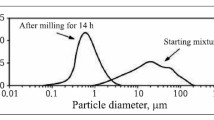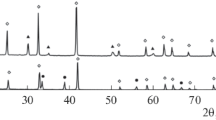Hot pressing of commercially available powders is used to prepare dense ceramic based on ZrB2 –SiC with different additives (Si3N4, TiSi2, ZrSi2, MoSi2). The main physicomechanical properties are measured in macro-specimens: ultimate strength in static three-point bending at room temperature 400 – 600 MPa, Vickers microhardness up to 15 GPa, and critical stress intensity factor up to 5.9 MPa·m1/2. Average LTEC, thermal diffusivity, thermal conductivity, and oxidation resistance over a wide temperature range are determined. Altogether the ceramic properties obtained are at the level of published indices.





Similar content being viewed by others
Notes
Any compounds of boron, zirconium, and hafnium are classified as strategic raw materials, on which there are export-import limitations. According to [10] within Russia currently there is almost complete absence of in-house production of zirconia refractories.
Ceramic machined surface was measured in a TR-200 profilometer according to GOST 2789.
In the course of treatment under vacuum in the initial HP stages boron oxide partly evaporates. The quantitative residue in ceramic was not evaluated in this work.
The temperature of 1400°C for UHTCM is its “boundary temperature”. Above 1400°C there is melting of silicon and marked softening of the glass phase of the composition Zr–B–Si–O at grain boundaries. Achievement of high strength at these temperatures is technically impossible [3], and is currently being studied. For use in hypersonic aircraft it is necessary that UHTCM have an ultimate strength in bending not less than 200 MPa at above 1500°C [3].
References
G. V. Samsonov, T. I. Serebryakova, and V. A. Neronov, Borides [in Russian], Atomizdat, Moscow (1975).
T. I. Serebryakova, V. A. Neronov, and P. D. Peshev, High-Temperature Borides [in Russian], Metallurigiya, Moscow (1991).
W. G. Fahrenholtz, E. J. Wuchina, W. E. Lee, and Y. Zhou (editors), Ultra-High Temperature Ceramics. Materials for Extreme Environment Applications, Wiley, New Jersey (2014).
K. Sonber and A. K. Suri, “Synthesis and consolidation of zirconium diboride: Review,” J. Adv. App. Ceram., 110(6), 321 – 324 (2011).
E. P. Simonenko, D. V. Sevast’yanov, N. P. Simonenko, et al., “Simonenko, E. P. Promising ultra-high temperature ceramic materials for aerospace applications,” Russ. J. Inorg. Chem., 58(14), 1669 – 1693 (2013).
R. A. Andrievskii, “Nanostructured diborides of titanium, zirconium, and hafnium: synthesis, properties, dimensional effects, and stability,” Uspekhi Khimii, 84(5), 540 – 554 (2015).
L. A. Chevykalova, I. Yu. Kelina, I. L. Mikhal’chik, et al., “Preparation of ultra-high temperature ceramic material based on zirconium boride by SPS method,” Refract. Indust. Ceram., 54(6), 455 – 462 (2014).
D. V. Grashchenkov, O. Yu. Sorokin, Yu. E. Lebedeva, and M. L. Vaganova, “Specific features of sintering of HfB2-based refractory ceramic by hybrid spark plasma sintering,” Russ. J. App. Chem., 88(3), 386 – 393 (2015).
S. S. Ordan’yan, V. I. Rumyantsev, D. D. Nesmelov, and D. V. Korablev, “Physicochemical basis of creating new ceramics with participation of boron-containing refractory compounds and its practical implementation,” Refract. Indust. Ceram., 53(2), 108 – 111 (2012).
V. A. Sokolov, “Production condition and raw material base of zirconia refractories in Russia,” Novye Ogneupory, No. 11, 13 – 17 (2013).
G. S. Khodakov, “Method for measuring specific surface of verified powders by gas filtration,” Kolloid. Zh., 57(2), 280 – 282 (1995).
J. F. Justin and A. Jankowiak, “Ultra-high temperature ceramics: densification, properties and thermal stability,” J. Aerospace Lab., No. 3 (2011).
N. Gupta, A. Mukhopadhyay, K. Pavani, and B. Basu, “Spark-plasma sintering of novel ZrB2–SiC – TiSi2 composites with better mechanical properties,” Mater. Sci. Eng. A., 534, 111 – 118 (2012).
S.-Q. Guo, T. Nishimura, T. Mizuguchi, and Y. Kagawa, “Mechanical properties of hot-pressed ZrB2–MoSi2 – SiC composite,” J. Europ. Ceram. Soc., 28, 1891 – 1898 (2008).
O. N. Grigoriev, B. A. Galanov, V. A. Kotenko, et al., “Mechanical properties of ZrB2–SiC (ZrSi2) ceramics,” J. Europ. Ceram. Soc., 30, 2397 – 2405 (2010).
J. W. Zimmermann, G. E. Hilmas, W. G. Fahrenholtz, et al., “Thermophysical properties of ZrB2 and ZrB2–SiC ceramics,” J. Amer. Ceram. Soc., 91, 1405 – 1411 (2008).
F. Monteverde, S. Guicciardi, and A. Bellosi, “Advances in microstructure and mechanical properties of zirconium diboride based ceramics,” Mater. Sci. Eng. A, 346, 310 – 319 (2003).
R. Loehman, E. Corral, H. P. Dumm, P. Kotula, and R. Tandon, “Ultra-high temperature ceramics for hypersonic vehicle applications,” Sandia Report, USA (2006).
The authors of the article thank R. A. Mironov, T. A. Mishnova, T. S. Frolova, I. M. Rudykin, and G. M. Bagreeva for participation in the work.
Author information
Authors and Affiliations
Corresponding author
Additional information
Translated from Novye Ogneupory, No. 1, pp. 33 – 39, January, 2017.
Rights and permissions
About this article
Cite this article
Sokolov, P.S., Arakcheev, A.V., Mikhal’chik, I.L. et al. Ultrahigh-Temperature Ceramic Based on ZrB2–SiC: Preparation and Main Properties. Refract Ind Ceram 58, 46–52 (2017). https://doi.org/10.1007/s11148-017-0052-9
Received:
Published:
Issue Date:
DOI: https://doi.org/10.1007/s11148-017-0052-9




